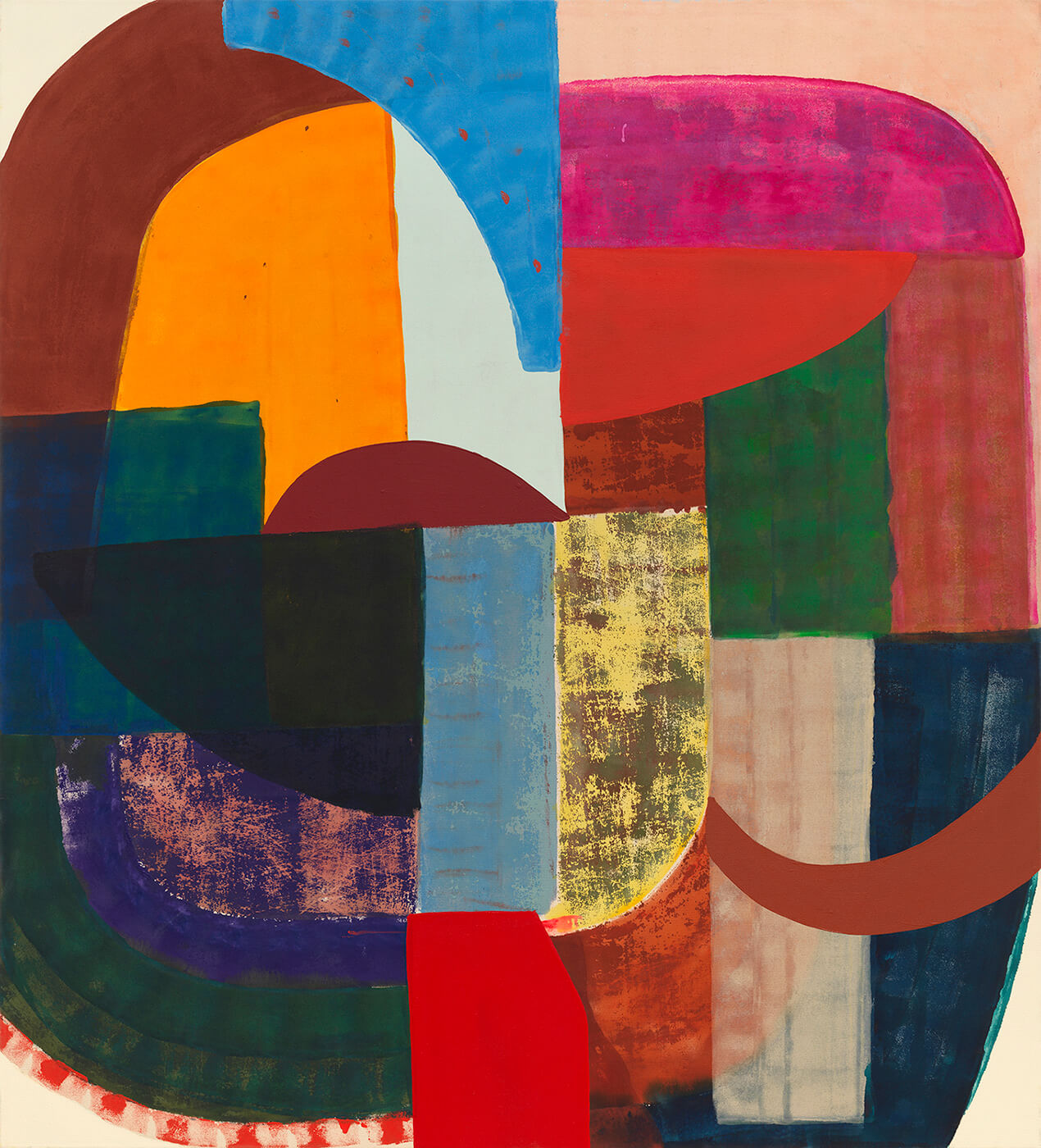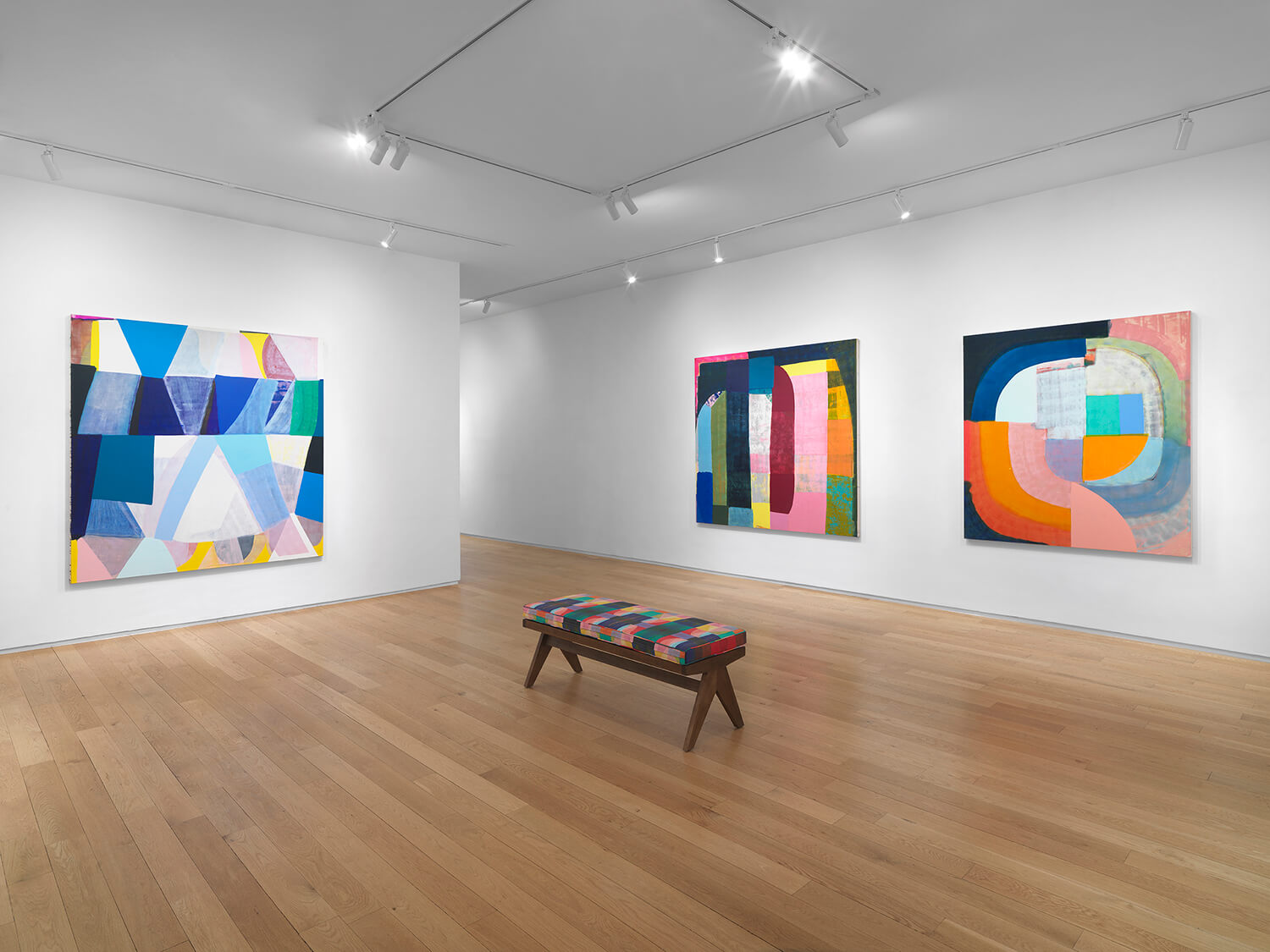
Anna Kunz
Tuning The Void, 2024
acrylic on canvas
66 x 60 in. (167.6 x 152.4 cm.)
May 15-June 26, 2024
Alexander Berggruen is pleased to present Anna Kunz: Paintings to the Full Flower Moon. This exhibition will open Wednesday, May 15, 2024 with a 5-7 pm reception at the gallery (1018 Madison Avenue, Floor 3, New York, NY).
Anna Kunz makes luminous, vibrant paintings with an emphasis on color, material, and process. Her practice thoughtfully considers the viewer’s experience, taking into account—with deep awareness and intentionality—how each work, each gesture, affects the exhibition space and, by extension, the viewer.
Her new exhibition takes as its starting point the full moon of May, which the artist considers to be a time of new beginnings. Her father, a master gardener, often told her “everything depends on the moon.” For Kunz, this paternal reminder that all beings are interrelated is particularly significant during challenging times. Kunz’s new work responds to her sense of urgency surrounding the need for more communal spaces for collective contemplation and joy, as a balm against the current political climate in which we find ourselves.

The artist uses painting to suggest a way of looking (and being in the world) that privileges sensation over interpretation, grounding the viewer in the present moment while also offering multiple perspectives. Kunz rewards deep looking with an opportunity to reflect on the profundity, and fragility, of life. Her work springs forth from near mystical combinations of disparate historical sources, personal memories and collective experiences. These include traditions of tantric art and visualizations of artists including Sonia Delaunay, Hilma af Klimt, and Charmion von Wiegand.
Kunz is equally interested in the canvas’s relationship to her own body: in Kunz’s practice, these are inextricably linked. The scale of her paintings is derived from the length of her wingspan; thus, each of the works takes up as much space as her body possibly could. With her canvases laid flat on the floor of her studio, she traverses a wooden plank laid overtop in order to access each register, incorporating movement into her process of making.
Kunz’s palette here is a bit darker, a bit deeper, than in previous bodies of work, suggesting the moon’s illumination of the dark landscape at night. Charged optical relationships emerge from lushly saturated and muted colors, melded through slow layering. The paintings practically glow from within, seemingly shining a warm, lunar light. Color intervenes and signals alarm, but ultimately Kunz’s embrace of vibrant color offers positivity. Sensual maroons, canary yellows, blushing corals, fervent reds, and a full spectrum of blues (nocturnal, crepuscular, and daylight) are informed by the artist’s sensorial memories of seeing the colors of a moonlit spring garden in full bloom. Kunz surrounds her viewers with color, oscillating shapes, and variegated textures to reflect and share this experience. “With painting, I am interested in using color to facilitate a relational experience for my viewers, revealing the perceptual instability of colors, and their contingency on light, time, distance, and perspective,” explains Kunz.

Rooted in the power of discovery and influenced by the likes of Helen Frankenthaler, Miyoko Ito, and Paul Klee, the artist’s practice is generative, and her formal language repeats and expands from painting to painting, creating an ensemble in which each work embodies an echoing effect. The paintings in Full Flower Moon began with a technique Kunz calls “fabric transference,” in which she presses paint through fabric to transfer a singular composition onto multiple canvases, much like monotypes. This process results in the paintings possessing the same colors and shapes for their base layer. However, the paintings are then individuated with further paint application, playing with color, rhythm, visual weight, and emphasis. Kunz “paints on, in, and through the surface,” as she puts it. Much like experimental music, Kunz’s paintings feel spontaneous but considered, informed by her understanding of colors’ potential to evoke feeling, sensation, and associations.
Geometry in Kunz’s work exists in a graceful, precarious balance. Suggesting the illusion of space and volume with imperfect rectangles that are often curvilinear, Kunz employs these bowed forms to achieve, in her words, “The circular sort of form that I’m forcing out of the square.” From a spiritually and symbolically formal perspective, the circle may be representative of the perfect and divine, or perhaps an allusion to the life cycle. Kunz’s forms oscillate between opaque shapes with harder edges that push a viewer out and translucent colors that bleed into one another and pull a viewer in. The solid cutout qualities of the former are reminiscent of collage. Kunz is considering the grief and rebirth of cutting something from its origins and optimistically giving it a new life in a new context, as described in art historian Rachel Haidu’s affect theory of collage (1). Faced with the existential threats of mortality and political turmoil, Kunz generously gifts us paintings that ecstatically reflect the emotive light of life.
(1) Rachel Haidu, Each One Another: The Self in Contemporary Art, University of Chicago Press, 2023.
Anna Kunz in the studio, Mana Contemporary, Jersey City, NY, 2024.
This exhibition follows the artist’s first solo show with the gallery Anna Kunz: With Rays (October 20-November 20, 2021), her inclusion in the gallery’s group show Shapes (April 21-May 27, 2021), and her inclusion in the gallery’s presentation at The Dallas Art Fair (April 4-7, 2024). Alexander Berggruen represents the artist.
Anna Kunz received an MFA from Northwestern University, Evanston, IL and a BFA from The School of the Art Institute of Chicago, Chicago, IL. Kunz participated as an artist-in-residence in the Marie Walsh Sharpe Studio Program, Brooklyn, NY; and The Skowhegan School of Painting and Sculpture, Skowhegan, ME, among others. She is a 2024 Monira Foundations Artist in Residence at Mana Contemporary, Jersey City, NJ. The artist’s work has been exhibited at: Alexander Berggruen, New York, NY; Berggruen Gallery, San Francisco, CA; McCormick Gallery, Chicago, IL; The Hyde Park Art Center, Chicago, IL; Providence College Galleries, Providence, RI; TSA Gallery, Los Angeles, CA, Brooklyn, NY, and Madrid, Spain; and WhiteBox, New York, NY. Her work is included in the public collections of The Philadelphia Museum, Philadelphia, PA; The Block Museum, Chicago, IL; and Columbia University Teachers College, New York, NY; among others. Kunz has been honored with nominations from: Anonymous Was a Woman, 3Arts Foundation, Louis Comfort Tiffany Foundation, Richard H. Driehaus Foundation, Emerging Artist award from the National Museum of Women in the Arts, Artadia finalist, Chicago, the Rema Hort-Mann Foundation’s Individual Artists Grant, and The Joan Mitchell Foundation. As a current artist in residence with the Monira Foundation at Mana Contemporary, Kunz lives and works in New York, NY and Chicago, IL.
On the occasion of this exhibition, Alexander Berggruen will publish an exhibition catalogue featuring a new essay by art critic, art historian, and poet Barry Schwabsky.
Anna Kunz: Paintings to the Full Flower Moon will run at Alexander Berggruen (1018 Madison Avenue, Floor 3) from May 15-June 26, 2024. The exhibition’s preview is available upon request. For all inquiries, please contact the gallery at info@alexanderberggruen.com.
Once in a while you can get shown the light. Anna Kunz’s Paintings to the Full Flower Moon, on view at Alexander Berggruen through June 26th, offers up eleven new acrylics-on-canvas that dance playfully along the lines between the earthly and celestial while retaining the craft-forward frankness of 2021’s With Rays. Kunz’s sun-drenched psychic geometries are winners on their own, with a leaning towards the spiritual that serves to bolster, not diffuse, their immense craftsmanship. Within the context of a city whose art world wrestles with the Dark Side and a worldwide “vibe-shift” permeating across media, this array of celestial openings in the Upper East Side feels practically miraculous.
What makes this exhibition so great is Kunz’s insistence on humanity: a devotion with the courage to grasp our hands and pull us along. Kunz’s work reinforces the all-too-primal instinct to conjure up new worlds, not to distract us from our real one but to reaffirm our place as conscious beings. Make the trip and feel whole again. You’ve got two weeks.
For Chicago-based painter Anna Kunz, color never sits still. “In a composition, it moves and vibrates,” she says. “It’s alive and engaging—the opposite of static.”
The artist, whose aesthetic forebears include such people as Robert Irwin and Josef Albers, learned about color’s emotive powers early in life. Her father worked at the Art Institute of Chicago, where a young Kunz often waited for him while parked in front of Mark Rothko’s shimmering Untitled (Purple, White, and Red). “I observed how some people laughed, some got angry and others wept,” she recalls. “At 7 years old, I didn’t know color would be my lifelong pursuit—but I saw its potential to evoke a response.”
Today, Kunz—who divides her studio time between the Austin neighborhood and rural Michigan—is known for making viewers rethink the hues they take for granted with works on paper, canvas and textiles. “I enjoy fairly simple geometric forms because I am interested in pigments being perceived first,” she says, noting that color can affect everything from our heartbeats to our circulatory systems. She also explores how the perception of a particular hue depends on its surroundings. “Albers put it perfectly,” says Kunz, paraphrasing the 20th-century German American artist: “No one color is true—it is only determined by its relation to another color.”
In Kunz’s Austin studio, smaller works on paper are arrayed on countertops while larger canvases are spread on the floor. She moves between them via wooden planks in a kind of dance, painting to the sounds of experimental music. “My process is generative—I consider everything as part of a continuum,” says Kunz, who applies oils with a brush and acrylics with objects plucked from the domestic realm—spatulas, hairbrushes, bits of fabric, curlers—as well as found items, like leaves. “And I use a lot of water, because I like to dissolve hard-edged boundaries,” she adds. Kunz builds a rich depth of color by layering multiple thin films of pigment. She works with only a couple of different hues in a given day, assigning each one its own specific task: “For example, I might want my red to feel submissive in one piece and more dominant in another,” the artist explains. “I use colors like characters to satisfy different formal problems.”
Kunz, who has an upcoming solo show at New York’s Alexander Berggruen gallery in May and a group show at Detroit’s Library Street Collective in July, knows a painting is finished when it starts to take on a life of its own and feels unexpected—“like a surprise,” she describes. “When I sense light emitting from the color, I feel I’ve created a kind of optimism, and that’s when it’s time to leave it alone.”
Anna Kunz: Paintings to the Full Flower Moon will be published on the occasion of the gallery’s eponymous exhibition, which ran from May 15-June 26, 2024. This catalogue features an essay by art critic, art historian, and poet Barry Schwabsky.
Pre-orders expected to be shipped in mid-July.